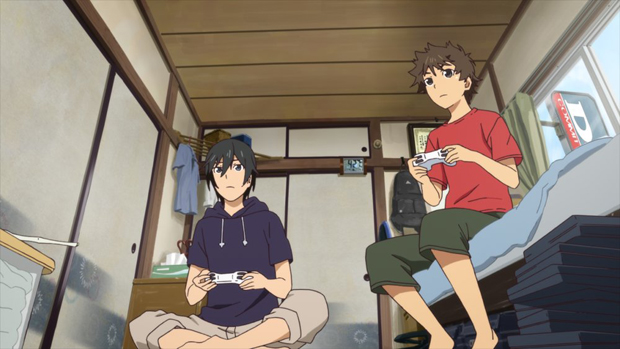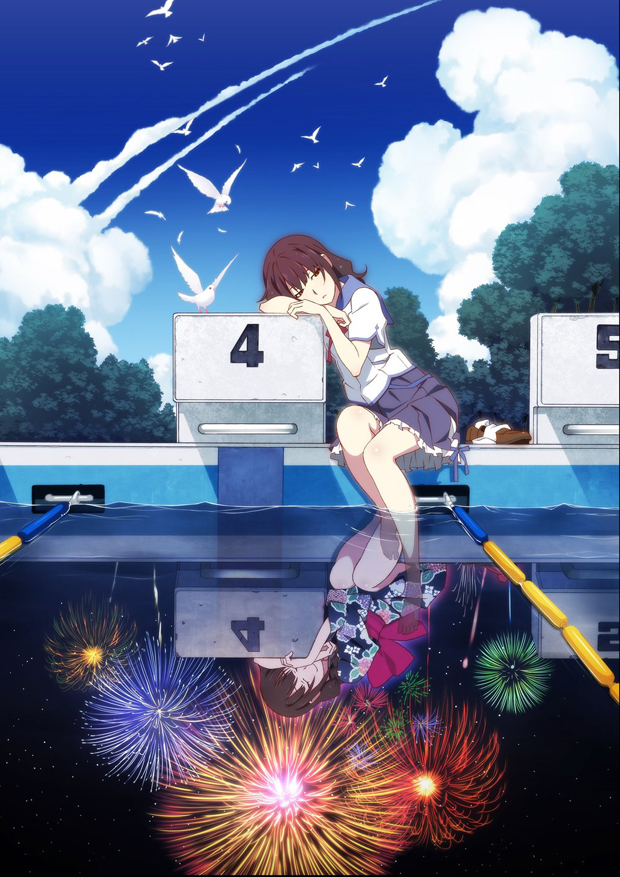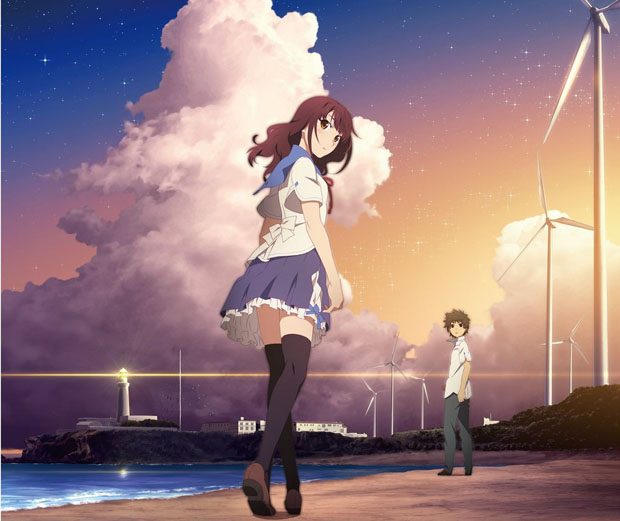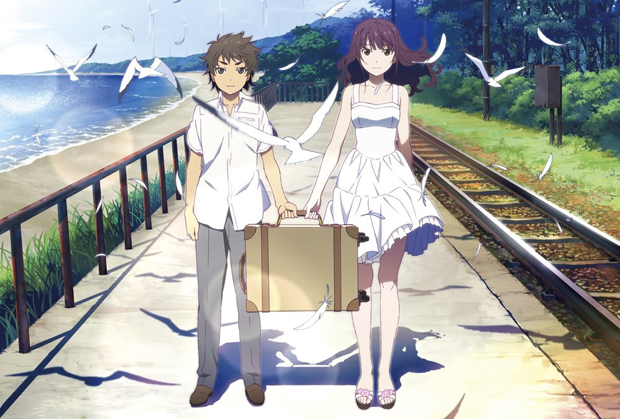Producer Genki Kawamura discusses the making of this time-bending animated feature.
By Charles Solomon
At a time when American filmmakers have attempted to remake anime properties in live action with limited success at best, Fireworks, Should We See it from the Side or the Bottom? (2017), which was released by Fathom Events and GKIDS in U.S. theaters this week, is a remake of a live action film in animation. Directed by Akiyuki Shinbo (co-directed by Nobuyuki Takeuchi) from a screenplay by Hitoshi Ohne, Fireworks focuses on a curious high school romantic triangle in a seemingly normal seaside town in Northern Honshu–where time and space ripple and distort.
Norimichi (Ryan Shanahan) and Yusuke (Aaron Dallas Villa) both like their pretty classmate Nazuna (Brooklyn Nelson), but neither of them can muster the nerve to declare their affection. Yusuke makes a date with her to see a fireworks show that promises to provide a welcome bit of excitement during a hot, boring summer, but loses his nerve. When Norimichi fills in, he discovers Nazuna is so unhappy about her mother remarrying and moving the family to Tokyo, she asks him to help her run away. Their attempted flight is complicated by the discovery of a mysterious crystal sphere that alters reality around them.
Producer Genki Kawamura, whose work includes such notable films as Wolf Children, The Boy and the Beast and Your Name, talked about Fireworks in a recent interview conducted via email. He began, “I’m a fan of the original drama by writer-director Shunji Iwai. I thought it would be impossible to remake it as a live action film. However, my experience working in animation with Mamoru Hosoda and Makoto Shinkai led me to believe I could remake the story, using animation’s power to depict that same glorious, youthful moment.”
A Recurring Time Loop
The original Fireworks, which was released in 1995 (but is not available in the U.S.), was a short film. To expand the story, the filmmakers decided to repeat the time jumps. “In contrast to the original movie, the time loop occurs again and again. Every time the time loop occurs, the world becomes more animated, fantasy-like and two dimensional,” Kawamura explains. “This directorial technique was suggested by Shinbo when he re-envisioned the story in animation. Then Ohne wrote the ‘continuation’ of the original story.”
A central element in the film is the “If Sphere,” the innocuous seeming crystal orb Nazuna finds as she’s wading at the sea shore. This mysterious object causes time to jump back and the surrounding world to alter, but the shifts occur so subtly, Nazuna and Norimichi initially don’t realize what’s happened.
“The time loops occur again and again and the “If Sphere” was created as the devise to cause those shifts,” Kawamura continues. “Fireworks is set in Moshimo, which is based on the town where the original drama was shot twenty years ago. But the town was devastated by the 2011 Tōhoku earthquake and tsunami (which Americans refer to as “Fukushima”). The thoughts of the people who died in that disaster (including Nazuna’s father), accumulated in the ocean. The Sphere was formed from them, then washed ashore. It makes Nazuna, who picked up it, see a ‘what-if’ world”.
Is It the Real World?
Many recent anime films and series have depicted an uncertain reality where neither the viewer nor the characters can be sure what does and doesn’t actually exist. In Satoshi Kon’s Millennium Actress, the characters move effortlessly from present to past, from reality to fantasy and from memory to film. Makoto in Hosoda’s The Girl Who Leapt Through Time keeps reliving a specific afternoon, trying to prevent an accident and its aftermath with increasingly disturbing results. Self-proclaimed “mad scientist” Rintaro Okabe and his friends fiddle with the space-time continuum to create a series of alternate Akihabara’s in Steins;Gate.
When asked about the uncertain worlds in his films, Kon replied, “I think that shimmering identity is something very ordinary and usual in the mentality of a country that does not have an absolute religion like Christianity. We believe in multiple nature gods and goddesses, not one god, and I think that the quivering nature of reality is a product of that belief. Human experience is not always objective: we cannot share it with other individuals accurately.”
Kawamura takes a more pragmatic view: “As young Japanese grow up with a lot of manga and animation, they tend to imagine moving between reality and fiction; I do, too. I think shifting realities are easier for them to accept, but this Japanese sensibility is universal among audiences to some degree.”
Cruel Summer
As has been true in many recent anime films, notably Hosoda’s Summer Wars, the oppressive Japanese summer becomes almost another character in Fireworks. Kawamura continues, “We tried to recreate the heat and humidity of the Japanese summer, which was evident in the original live-action movie. I visited and took pictures of the summer scenery at the location the original film was shot, then carefully drew them. One of the best parts of making the animation from the live-action work was depicting the scenery.”
Fireworks played well in China before opening in America. Kawamura, who cites Steven Spielberg, J.J. Abrams, Hideaki Anno, Mamoru Oshii and Hayao Miyazaki as major influences, dismisses the idea of having had either a specifically Japanese or foreign audience in mind when he made the film. “Most people in the world might think: ‘If I could go back to the day,’” he says thoughtfully. “I think there was a similar idea depicted in Your Name. The adventures of a young boy who has the ability to go back in time would excite people anywhere in the world. I never distinguish my works for Japanese or for overseas audience when I make them. I’ve been searching for a feeling audiences all over the world are experiencing right now. I think the feeling of ‘If I could go back to that day’ is shared everywhere in the world right now.”
American audiences will be able to see Kawamura’s latest film when Hosoda’s Mirai of the Future plays in America this fall. It was chosen for the Director’s Fortnight, which runs parallel to the Cannes Festival, a first for a Japanese director. He concludes, “This year, I established STORY Inc., an animation planning company, and I’m preparing for projects with about five Japanese animation directors of the next generation. The next film of Makoto Shinkai is one of those projects.”
You can watch the trailer here.
Fireworks plays in theaters on July 7. For more info, visit www.fathomevents.com/events/fireworks









 Win a Funko X Lilo & Stitch Prize Pack!
Win a Funko X Lilo & Stitch Prize Pack! 
